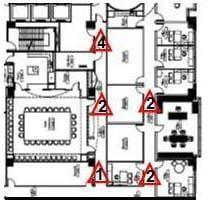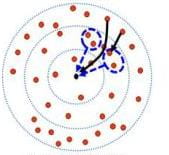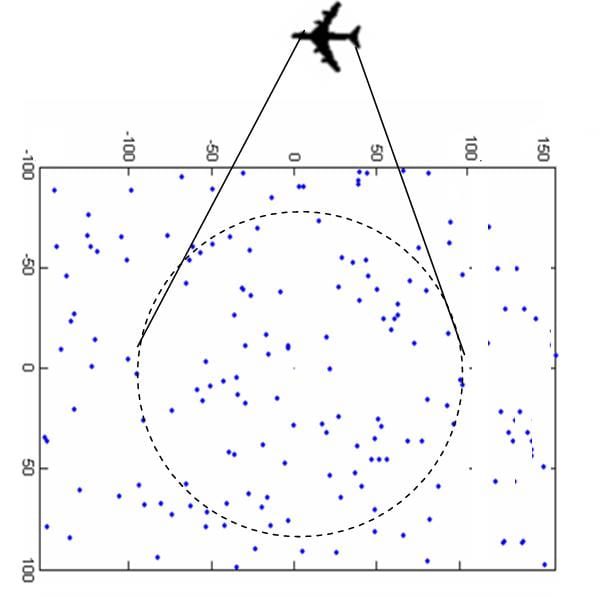Reaching Farther with Concurrent Cooperative Transmission (CCT)
 A cluster of two or more physically separated radios transmit at the same time to extend the range of radio transmission much beyond the distance a lone, single-antenna radio can reach. CCT range extension is demonstrated experimentally on software-defined radios, using a practical transmit synchronization method for non-coherent FSK.
A cluster of two or more physically separated radios transmit at the same time to extend the range of radio transmission much beyond the distance a lone, single-antenna radio can reach. CCT range extension is demonstrated experimentally on software-defined radios, using a practical transmit synchronization method for non-coherent FSK.
Extending Lifetime of a Multi-Hop Wireless Sensor Network with CT
 The range extension from CT discussed above can solve the energy hole problem in battery-driven multi-hop wireless sensor networks (WSNs).
The range extension from CT discussed above can solve the energy hole problem in battery-driven multi-hop wireless sensor networks (WSNs).
CT Energy Balancing Improves Throughput of Energy Harvesting WSNs
 The same mechanism that avoids the energy hole in battery-driven networks can be used to match energy consumption to energy production in energy harvesting nodes, leading to throughput improvements. Some preliminary results are shown in Fig. 4 for an 80-node network, assuming supercapacitor (SC)-only energy storage, each node starts with the same small amount of energy (1 J), and a harvesting rate of 40 mJ/min on average (to simulate pulses of vibration energy, such as from cars on a bridge).
The same mechanism that avoids the energy hole in battery-driven networks can be used to match energy consumption to energy production in energy harvesting nodes, leading to throughput improvements. Some preliminary results are shown in Fig. 4 for an 80-node network, assuming supercapacitor (SC)-only energy storage, each node starts with the same small amount of energy (1 J), and a harvesting rate of 40 mJ/min on average (to simulate pulses of vibration energy, such as from cars on a bridge).
 The OLACRA method mentioned above is the basis of the route request and route reply stages of the novel reactive OLA-based routing protocol, called OLAROAD, for ad hoc networks. No “primary” conventional mult-hop route is needed. Because the OLAROAD route is a strip that occupies area, this routing approach is very robust to node mobility
The OLACRA method mentioned above is the basis of the route request and route reply stages of the novel reactive OLA-based routing protocol, called OLAROAD, for ad hoc networks. No “primary” conventional mult-hop route is needed. Because the OLAROAD route is a strip that occupies area, this routing approach is very robust to node mobility
One-Shot Reading of Correlated Sensors Using Semi-Cooperative Spectrum Fusion
 A MAC-free method for obtaining an estimate of the histogram of sensor values within an area that is illuminated by a reader node. The method is shown to consume less energy for comparable estimator performance, when compared to a cluster-based MAC-aided scheme.
A MAC-free method for obtaining an estimate of the histogram of sensor values within an area that is illuminated by a reader node. The method is shown to consume less energy for comparable estimator performance, when compared to a cluster-based MAC-aided scheme.
Hybrid Energy Storage-Aware Routing for Saving Battery Cycle Life
 An hybrid energy storage system (HESS) has both a supercapacitor (SC) and a rechargeable battery (RB). Today, HESSs are used in some radios, with the SC playing the role of the “surge protector” for the RB; however, the RBs are still accessed for every transmission. Existing harvesting-aware routing protocols do nothing to avoid exhausting the short cycle life of RBs. We propose an HESS-aware routing protocol that utilizes the SC energy exclusively whenever possible, and when it is not possible, chooses the path that maximizes RB cycle life.
An hybrid energy storage system (HESS) has both a supercapacitor (SC) and a rechargeable battery (RB). Today, HESSs are used in some radios, with the SC playing the role of the “surge protector” for the RB; however, the RBs are still accessed for every transmission. Existing harvesting-aware routing protocols do nothing to avoid exhausting the short cycle life of RBs. We propose an HESS-aware routing protocol that utilizes the SC energy exclusively whenever possible, and when it is not possible, chooses the path that maximizes RB cycle life.
MIMO for RFID Modulated Backscatter to Increase RF Tag Data Transmission Rates
 The diode modulators on modulated backscatter-type RFID tags are extremely simple and consume very little power. If the reader and the tag each have multiple antennas separated by at least 1/4 wave length, then the tag can increase its data rate relative to the single-tag-antenna case by a factor equal to number of tag antennas. Fig. 8 shows one possible configuration
The diode modulators on modulated backscatter-type RFID tags are extremely simple and consume very little power. If the reader and the tag each have multiple antennas separated by at least 1/4 wave length, then the tag can increase its data rate relative to the single-tag-antenna case by a factor equal to number of tag antennas. Fig. 8 shows one possible configuration
Software Defined Radio Mesh Network

Last revised on Jan,28,2010.

